Key takeaways
- Activist teacher resources empower educators to engage students in critical discussions about real-world issues, fostering understanding and empathy.
- Integrating art into science education enhances comprehension, encourages creativity, and makes complex concepts more accessible and relatable.
- Practical methods like creating infographics, role-playing, and sketching during experiments promote active learning and deepen observation skills.
- Activism through art in science education encourages students to reflect on social and environmental issues, enhancing their engagement and motivation to enact change.

Understanding activist teacher resources
When I first encountered activist teacher resources, I wasn’t quite sure what to expect. But soon, I realized these tools are more than just lesson plans—they’re a call to action, designed to spark critical thinking and inspire change in the classroom. Have you ever felt that teaching could be more than just passing on facts? That’s exactly the heart of what these resources offer.
What strikes me most is how these materials encourage educators to challenge the status quo. It’s not just about delivering content but about engaging students in real-world issues with courage and empathy. I remember a time when using such resources transformed a routine discussion into a passionate conversation about social justice, and that moment stuck with me.
Understanding activist teacher resources means recognizing their power to empower both teachers and students. They invite us to ask difficult questions and explore multiple perspectives, often leading to a richer, more meaningful learning experience. Isn’t that something every educator strives for?
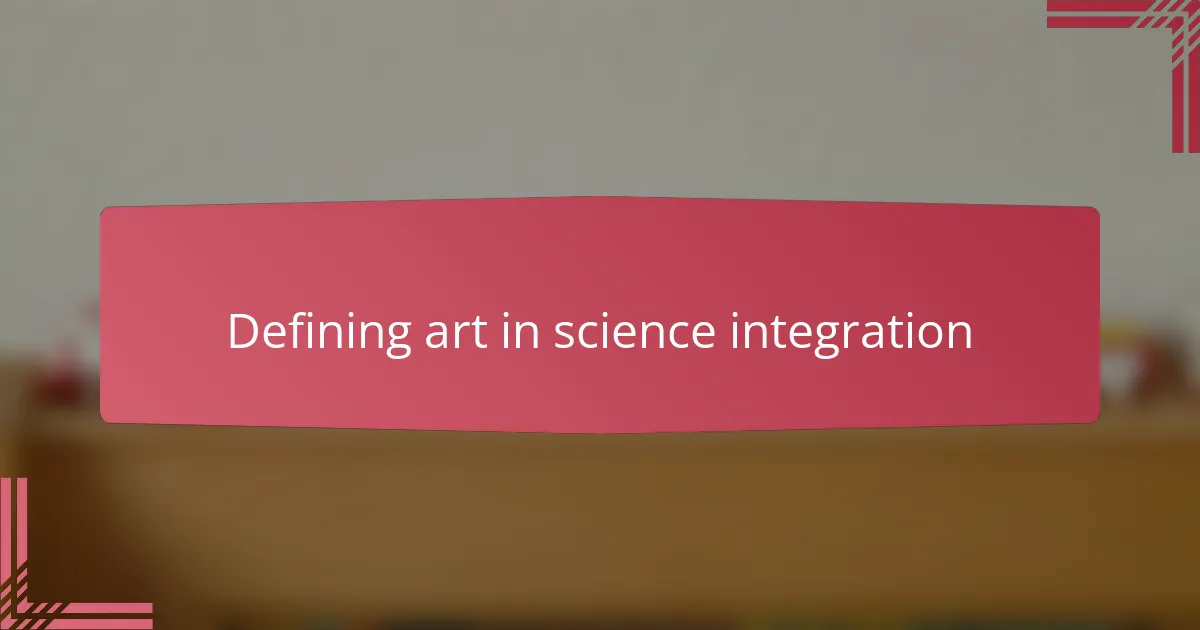
Defining art in science integration
Defining art in science integration can feel like trying to pin down a shape-shifting idea. To me, it’s where creativity meets inquiry—where the imaginative process of art adds a new layer of understanding to scientific concepts. Have you ever noticed how a carefully drawn diagram or a vivid metaphor can suddenly make a complex theory click?
I’ve found that incorporating artistic methods—like sketching, storytelling, or even music—brings science to life in a way pure data often can’t. It’s not just decoration; it’s a way to make abstract ideas tangible and relatable. When a student transforms a concept into a visual or performative piece, they’re not only showing what they know but also deepening their connection to the material.
So, when I think about art in science integration, I think about breaking boundaries. It challenges the idea that science is only about numbers and facts. It invites us to explore curiosity, emotion, and perspective, making science a more holistic experience. Doesn’t that sound like the kind of learning we want for every student?
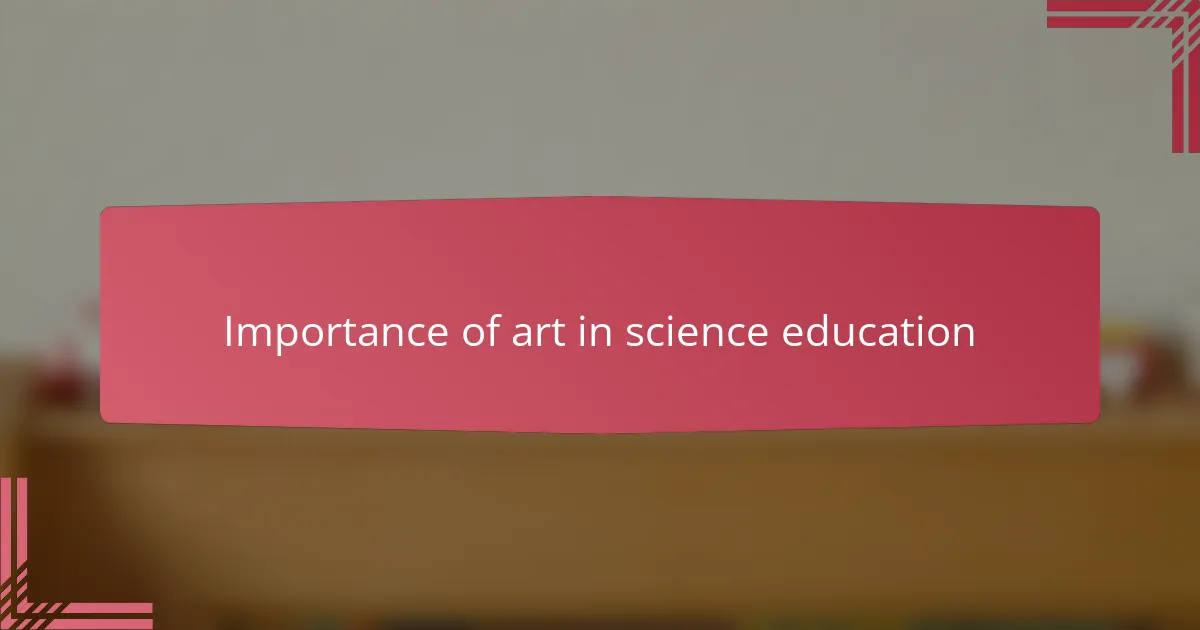
Importance of art in science education
Art in science education matters because it bridges the gap between logic and creativity. When I’ve watched students use drawings or models to explain a scientific process, I see their understanding deepen in ways that words alone can’t capture. Isn’t it fascinating how a simple sketch can unveil what a thousand lectures sometimes can’t?
In my experience, art brings accessibility to science. It invites learners who might feel intimidated by formulas and jargon to engage through a medium that resonates with them emotionally and intellectually. Have you ever noticed how students light up when they transform a complex concept into something visual or hands-on? That moment of clarity is powerful.
Beyond just aiding comprehension, incorporating art in science fosters critical thinking and innovation. It pushes students to observe details, draw connections, and imagine possibilities beyond textbooks. From my perspective, this is exactly the kind of mindset we want to nurture if we aim to prepare curious, adaptable scientists and citizens. Wouldn’t you agree that education should spark both knowledge and imagination?
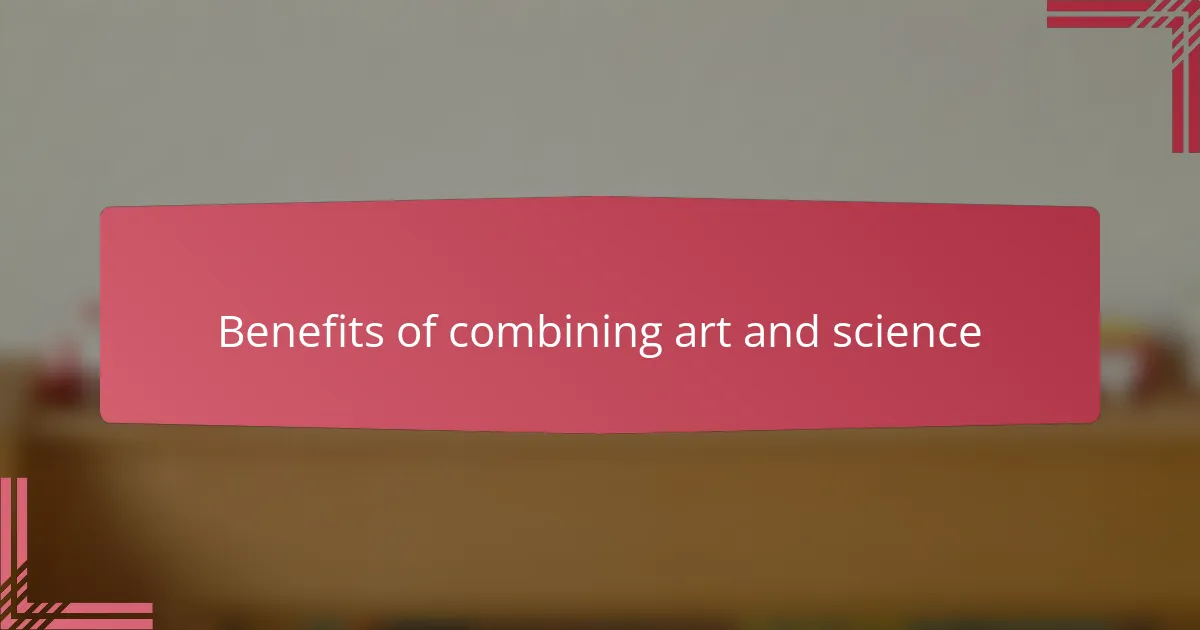
Benefits of combining art and science
Combining art and science offers a unique benefit: it transforms abstract concepts into something students can see and feel. I’ve seen firsthand how a student’s eyes light up when they create a visual representation of a scientific idea—it’s like the fog lifts, and understanding becomes real. Have you ever noticed how art makes science less intimidating and more inviting?
Another advantage is how this blend encourages diverse ways of thinking. When I used storytelling alongside biology lessons, students not only remembered facts better but also connected emotionally with the material. Doesn’t that deeper engagement make learning more meaningful and memorable?
Finally, integrating art fosters creativity in problem-solving. From my experience, students trained to think artistically about scientific challenges become more flexible and innovative thinkers. Isn’t that exactly the kind of skill set we want to develop in the next generation?
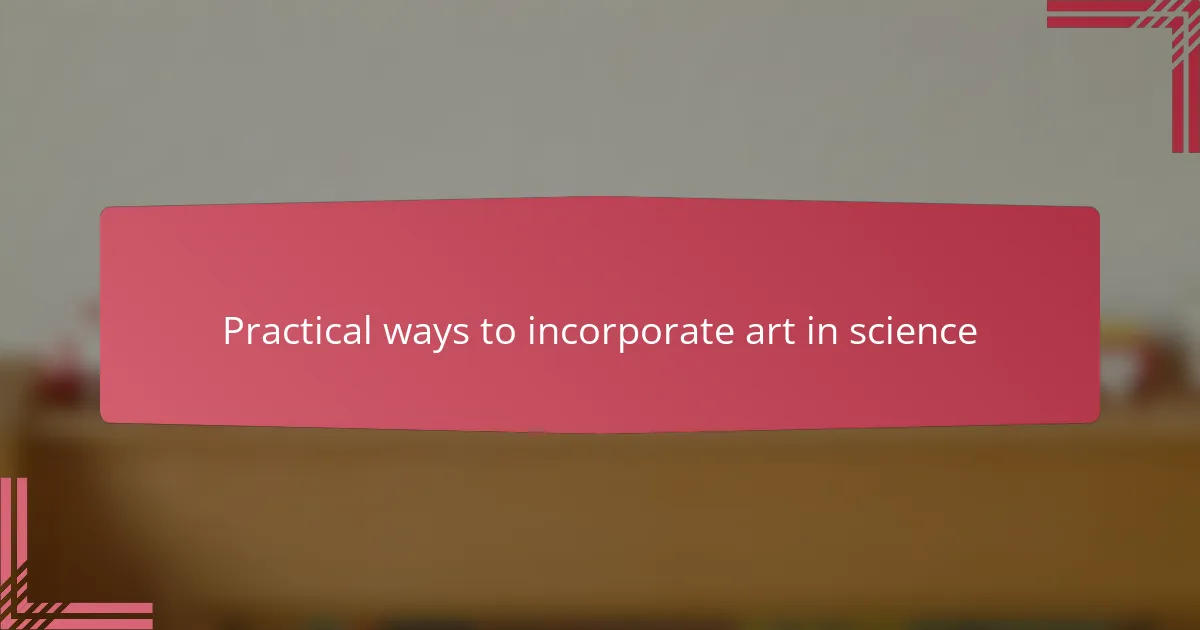
Practical ways to incorporate art in science
One practical way I’ve incorporated art into science is by having students create their own infographic posters to explain complex topics. I noticed this approach not only boosted their understanding but also gave them a chance to express their interpretation creatively. Have you ever tried turning a dry concept into an eye-catching visual? It changes everything.
Another method that worked well in my classes is using storytelling through role-play to explore scientific phenomena. Students become characters—like neurons passing signals or molecules reacting—and suddenly, abstract processes feel vivid and immediate. When they immerse themselves this way, engagement soars, and so does retention.
Sometimes, I encourage learners to sketch what they observe during experiments instead of just writing notes. This simple practice deepens their observation skills and makes learning more personal. Have you noticed how drawing forces you to pay closer attention? From my experience, it’s a small shift that opens the door to mindful science learning.
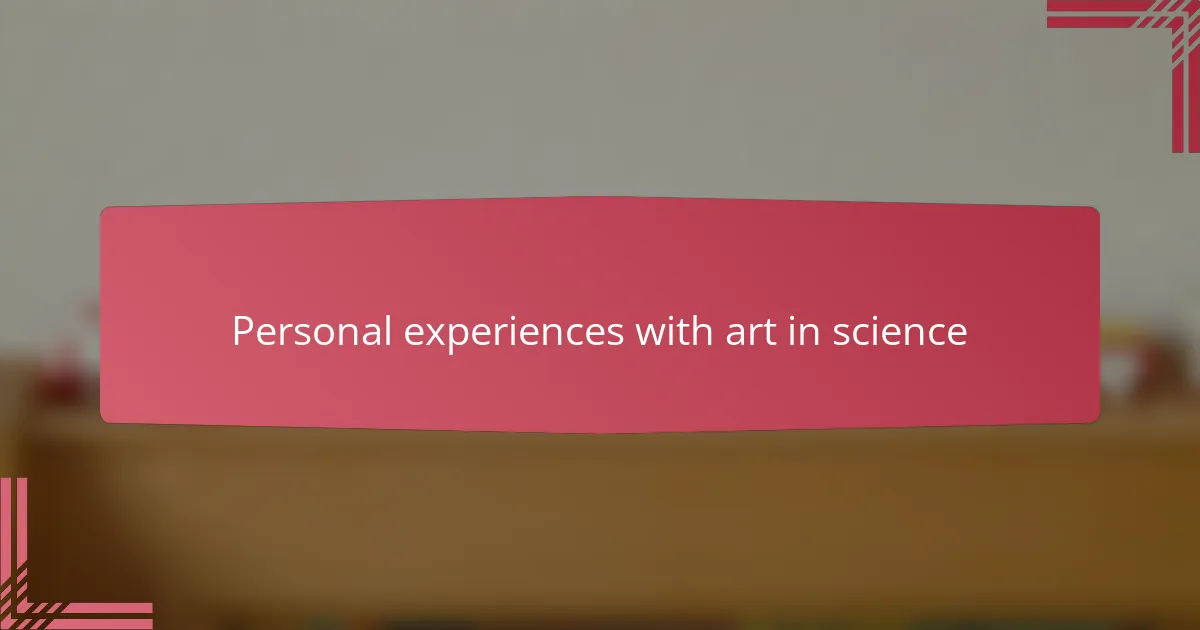
Personal experiences with art in science
I remember a project where I asked students to illustrate the life cycle of a butterfly as part of a biology unit. Watching them translate scientific stages into colorful drawings wasn’t just about art—it revealed how deeply they grasped the process. Have you ever seen a student’s eyes light up when their creativity unlocks understanding? That moment always reminds me why combining art and science is so powerful.
One time, I tried incorporating music to explain the periodic table’s patterns, and the shift in the classroom energy was palpable. Students who usually struggled with memorization started humming elements and even creating their own tunes. Isn’t it fascinating how bringing in an artistic element can turn frustration into fun and foster a genuine connection to content?
From personal experience, even simple sketching exercises during labs make a big difference. Instead of just jotting down observations, students engage with what they see, slowing down to notice details they might otherwise miss. Have you found that drawing can transform passive note-taking into active exploration? For me, that shift is key to developing deeper scientific curiosity.
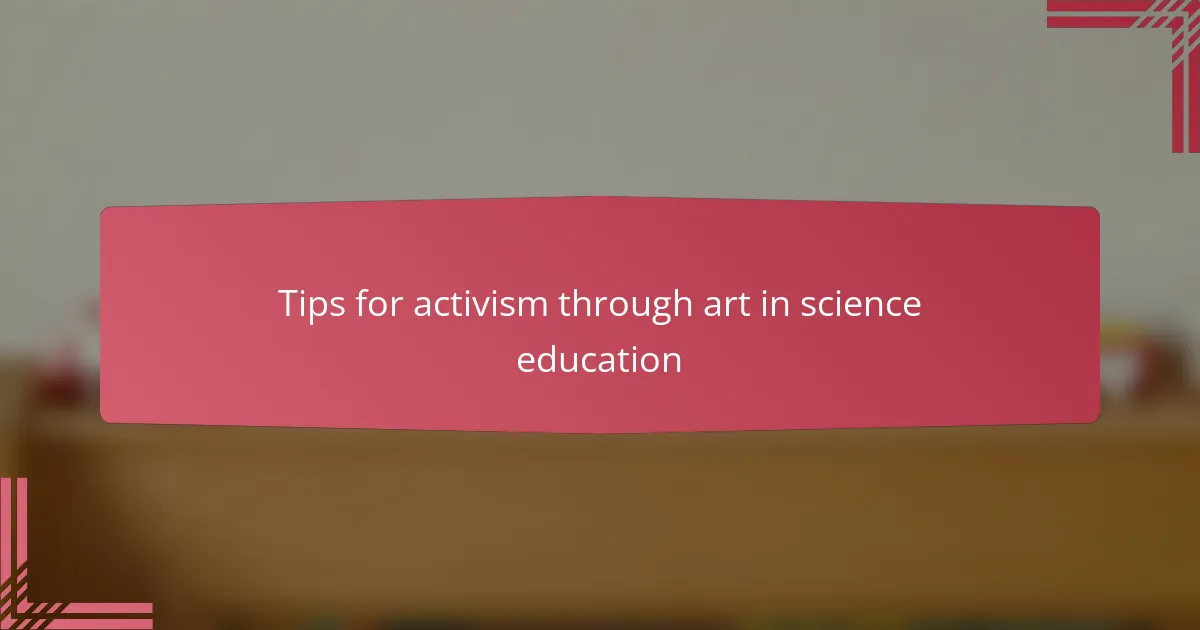
Tips for activism through art in science education
When I think about activism through art in science education, one tip that stands out is encouraging students to create pieces that reflect social or environmental issues linked to scientific topics. For example, having them design posters or murals about climate change not only deepens their scientific understanding but also empowers them to raise awareness creatively. Have you noticed how when students make art with a purpose, their engagement often skyrockets?
Another strategy I’ve found effective is integrating collaborative projects where students from diverse backgrounds combine their perspectives through art to explore a scientific concept. This not only fosters inclusivity but also sparks dialogue around justice and equity tied to the science lesson. Isn’t it incredible how art can be the bridge that brings difficult conversations into the classroom?
Finally, I always advocate for giving students space to reflect and express their feelings about scientific challenges through journal art or creative writing. This personal connection transforms activism from abstract ideas into heartfelt motivations for change. From my experience, when students see themselves in the science, their passion for action grows stronger—don’t you think that’s the kind of learning that truly sticks?